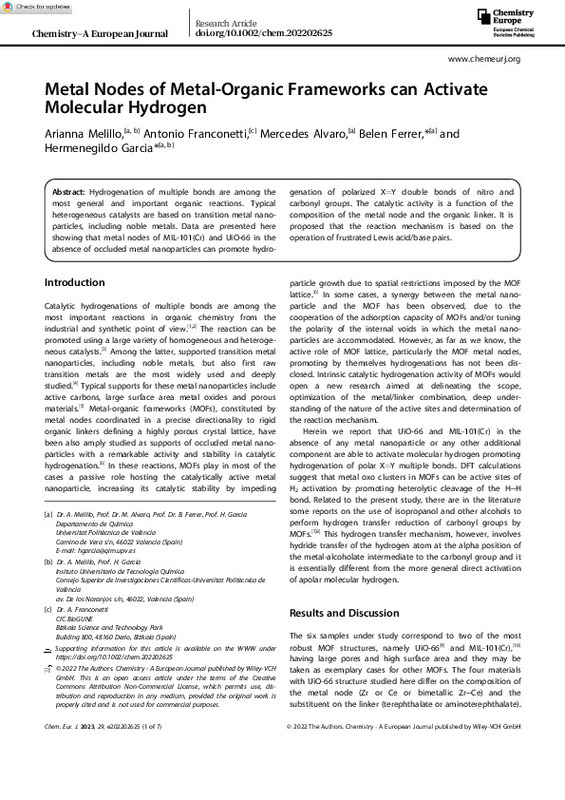JavaScript is disabled for your browser. Some features of this site may not work without it.
Buscar en RiuNet
Listar
Mi cuenta
Estadísticas
Ayuda RiuNet
Admin. UPV
Metal Nodes of Metal-Organic Frameworks can Activate Molecular Hydrogen
Mostrar el registro sencillo del ítem
Ficheros en el ítem
| dc.contributor.author | Melillo, Arianna
|
es_ES |
| dc.contributor.author | Alvaro Rodríguez, Maria Mercedes
|
es_ES |
| dc.contributor.author | Franconetti, Antonio
|
es_ES |
| dc.contributor.author | Ferrer Ribera, Rosa Belén
|
es_ES |
| dc.contributor.author | García Gómez, Hermenegildo
|
es_ES |
| dc.date.accessioned | 2024-02-29T19:02:46Z | |
| dc.date.available | 2024-02-29T19:02:46Z | |
| dc.date.issued | 2023-01-02 | es_ES |
| dc.identifier.issn | 0947-6539 | es_ES |
| dc.identifier.uri | http://hdl.handle.net/10251/202849 | |
| dc.description.abstract | [EN] Hydrogenation of multiple bonds are among the most general and important organic reactions. Typical heterogeneous catalysts are based on transition metal nanoparticles, including noble metals. Data are presented here showing that metal nodes of MIL-101(Cr) and UiO-66 in the absence of occluded metal nanoparticles can promote hydrogenation of polarized X=Y double bonds of nitro and carbonyl groups. The catalytic activity is a function of the composition of the metal node and the organic linker. It is proposed that the reaction mechanism is based on the operation of frustrated Lewis acid/base pairs. | es_ES |
| dc.description.sponsorship | Financial support by the Spanish Ministry of Science and Innovation (Severo Ochoa and PDI2021-126071-OB-CO21) and Generalitat Valenciana (Prometeo 2021-083) are gratefully acknowledged. Authors also thank the Galicia Supercomputing Centre (CESGA) for computational facilities. | es_ES |
| dc.language | Inglés | es_ES |
| dc.publisher | John Wiley & Sons | es_ES |
| dc.relation.ispartof | Chemistry - A European Journal | es_ES |
| dc.rights | Reconocimiento - No comercial (by-nc) | es_ES |
| dc.subject | Catalytic hydrogenation | es_ES |
| dc.subject | Heterogeneous catalysis | es_ES |
| dc.subject | Metal-organic frameworks as catalysts | es_ES |
| dc.subject | UiO-66 as hydrogenation catalyst | es_ES |
| dc.subject.classification | QUIMICA ORGANICA | es_ES |
| dc.title | Metal Nodes of Metal-Organic Frameworks can Activate Molecular Hydrogen | es_ES |
| dc.type | Artículo | es_ES |
| dc.identifier.doi | 10.1002/chem.202202625 | es_ES |
| dc.relation.projectID | info:eu-repo/grantAgreement/AEI/Plan Estatal de Investigación Científica y Técnica y de Innovación 2021-2023/PID2021-126071OB-C21/ES/APLICANDO MXENOS COMO CATALIZADORES DEFINITIVOS PARA LA PRODUCCION DE COMBUSTIBLES SOLARES/ | es_ES |
| dc.relation.projectID | info:eu-repo/grantAgreement/AGENCIA ESTATAL DE INVESTIGACION//CEX2021-001230-S//CENTRO DE EXCELENCIA SEVERO OCHO INSTITUTO DE TECNOLOGIA QUIMICA (ITQ)/ | es_ES |
| dc.relation.projectID | info:eu-repo/grantAgreement/GENERALITAT VALENCIANA//PROMETEO%2F2021%2F038//HETEROGENEOUS (ELECTRO-/PHOTO-)CATALYSTS FOR HYDROGEN TECHNOLOGY Cat4Hytec/ | es_ES |
| dc.rights.accessRights | Abierto | es_ES |
| dc.contributor.affiliation | Universitat Politècnica de València. Escuela Técnica Superior de Ingenieros Industriales - Escola Tècnica Superior d'Enginyers Industrials | es_ES |
| dc.description.bibliographicCitation | Melillo, A.; Alvaro Rodríguez, MM.; Franconetti, A.; Ferrer Ribera, RB.; García Gómez, H. (2023). Metal Nodes of Metal-Organic Frameworks can Activate Molecular Hydrogen. Chemistry - A European Journal. 29(1). https://doi.org/10.1002/chem.202202625 | es_ES |
| dc.description.accrualMethod | S | es_ES |
| dc.relation.publisherversion | https://doi.org/10.1002/chem.202202625 | es_ES |
| dc.type.version | info:eu-repo/semantics/publishedVersion | es_ES |
| dc.description.volume | 29 | es_ES |
| dc.description.issue | 1 | es_ES |
| dc.identifier.pmid | 36152311 | es_ES |
| dc.identifier.pmcid | PMC10100435 | es_ES |
| dc.relation.pasarela | S\480947 | es_ES |
| dc.contributor.funder | Generalitat Valenciana | es_ES |
| dc.contributor.funder | Agencia Estatal de Investigación | es_ES |
| dc.contributor.funder | Universitat Politècnica de València | es_ES |








